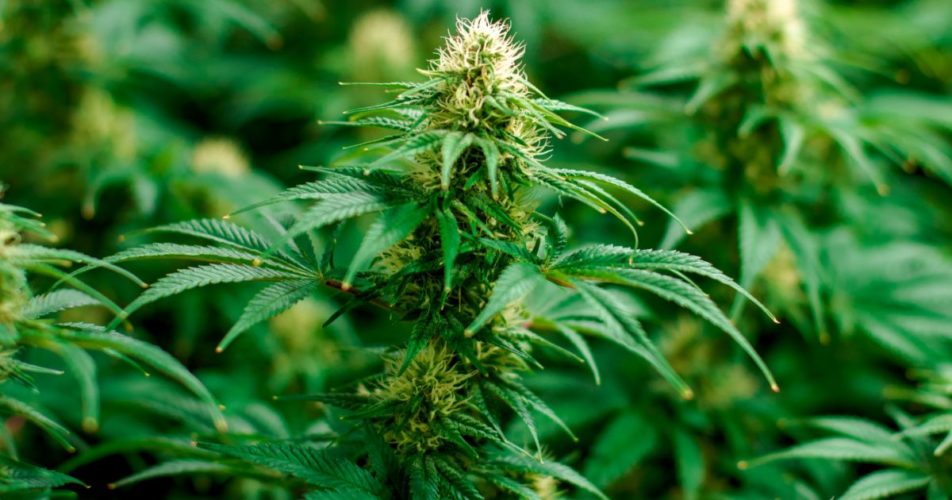Debunking Cannabis Myths is a journey into the heart of misinformation.
In fact, when it comes to understanding cannabis, the biggest hurdle many face is…
Debunking Cannabis Myths.
Countless individuals are caught in webs of half-truths and misconceptions about this plant. But separating fact from fiction is what distinguishes an informed consumer or cultivator from a misinformed one. If you don’t know how to discern myth from reality regarding cannabis, you’ll never fully grasp its potential benefits or challenges.
Cannabis Equipment News Podcast – Episode 9 – Debunking Cannabis Myths

Cannabis Equipment News is an interview series with growers, processors, distributors and other professionals who work within the legal cannabis industry. They provide answers to the challenges professionals face every day and discuss the industry as it continues to develop.
Table of Contents:
- The Role of Dr. Bruce Bugbee in Cannabis Research
- Understanding Light Pollution’s Effect on Cannabis
- Debunking Myths Surrounding Cannabis Cultivation
- Unique Nutritional Needs & Tolerance Levels Of Cannabis
- Benefits Of Higher Lighting Levels On Growth Rate
- Influence Of NASA Funding On Current Research
- Introduction Of A New Module Measuring Temperature And Humidity
- Offering Courses Related To Medical Cannabis Cultivation At Utah State University
- FAQs in Relation to Debunking Cannabis Myths
- Conclusion
The Role of Dr. Bruce Bugbee in Cannabis Research

At the forefront of cannabis research, we find figures like Dr. Bruce Bugbee, a renowned Professor at Utah State University and President of Apogee Instruments.
His contribution to this field? Nothing short than game-changing advancements that help growers optimize their operations and produce higher quality crops.
Development of Custom Instrumentation for Cannabis Growers
In his dual capacity as an academician and entrepreneur, Dr.Bugbee has been instrumental in creating custom instrumentation specifically designed for those who consume cannabis on various levels – from recreational users to medicinal patients seeking relief from chronic conditions. Apogee Instruments, under his leadership is making strides towards revolutionizing how people cite weed’s cultivation process with scientific precision.
This blend between science-driven innovation and practical application sets him apart within the industry while also helping debunk some myths surrounding marijuana usage among pot smokers today.
Potential Impact on the Cannabis Industry
Cannabis legalization trends worldwide have spurred demand for high-quality products leading big-time growers turning towards experts like Dr.Bugbee whose work could potentially reshape our understanding about cultivating this ancient plant species.
A study examining cannabis samples grown using different techniques can provide insights into optimizing growth parameters resulting in maximum yield & quality. (source) His lab’s ongoing efforts aim not only at dispelling misconceptions but also educating current generation farmers inspiring future ones aspiring to enter the burgeoning industry.
Dive into the game-changing cannabis research led by Dr. Bruce Bugbee, pioneering scientific precision in cultivation and debunking marijuana myths. #CannabisResearch #DebunkMythsClick to Tweet
Understanding Light Pollution’s Effect on Cannabis
Many things must be taken into consideration when cultivating cannabis in order to ensure a successful yield. One such factor that is often overlooked but can have significant impacts is light pollution.
A study examining cannabis samples has shown an intriguing sensitivity in these plants towards artificial lighting during their nighttime growth phase. This could be due to disruptions in cannabinoid receptor signaling caused by overexposure to light, although scientists can’t fully agree yet.
Delayed Flowering Due To Light Pollution
This sensitivity leads to delayed flowering when the plants are exposed excessively at night time. The delay may not seem like much initially, but it significantly affects both quality and quantity of harvested products down the line.
Pot smokers today need to understand this as consuming marijuana grown under high levels of nighttime light pollution might result in less potent buds with decreased THC concentration. It’s crucial for growers and consumers alike to recognize how environmental variables impact product outcomes substantially.
Requirement For Reagent Grade Darkness
To combat issues related with excessive illumination, stringent control measures must be implemented within cultivation processes. One major requirement being ensuring reagent grade darkness during plant’s nocturnal cycle. This level necessitates specialized equipment capable measuring below threshold levels unwanted lights inside grow rooms or greenhouses where weed grows.
- Maintaining Proper Dark Periods:
The importance maintaining strict dark periods cannot be overstated. It promotes optimal flowering times while contributing healthier plants producing higher yields better-quality buds rich desired cannabinoids CBD THC. As research continues understanding aspects influencing successful cannabis practices including debunking myths surrounding full moon planting cycles among others, the significance controlling environment becomes increasingly evident.
Unraveling the truth about cannabis cultivation: Light pollution can delay flowering and decrease THC concentration in buds. For quality yields, maintaining strict dark periods is crucial. #CannabisFacts #DebunkingMythsClick to Tweet
Debunking Myths Surrounding Cannabis Cultivation
Cannabis cultivation is often surrounded by a fog of myths and misconceptions. But fear not, Dr. Bruce Bugbee’s lab team has taken up the mantle to clear this haze with scientific evidence.
Let’s dive into how they’re dispelling these common cannabis tales.
List Creation of Commonly Held Myths
The first step in their myth-busting mission? They’ve crafted an extensive list of widely held beliefs about growing weed. This includes everything from planting seeds during full moon cycles for better yield, to people citing weed’s lack as a reason for laziness or unproductivity.
Myth #1: “Cannabis won’t make you lazy”, was one such belief that needed addressing. A study examining various cannabis samples found no conclusive evidence supporting this claim – thus debunking it.
Scientific Evidence Against/For These Myths
To separate fact from fiction, the team conducts thorough research using cutting-edge techniques and methodologies. For instance, animal studies suggest CBD might actually increase alertness – contradicting Myth #1 above directly.
THC’s immediate effect on the body, was another subject under scrutiny where scientists can’t fully agree due to THC consumption variations among marijuana users. However, recent findings indicate cannabinoid receptor signaling does indeed get triggered almost immediately upon smoking marijuana – busting yet another popular myth.
With continuous exploration like this on synthetic weed circulating nowadays and harmful synthetic drug effects comparison with natural ones, we are steadily moving towards an informed pot smokers today community. The more we know, lesser chances there will be any illicit drugs or harmful synthetic weed products slip through our awareness net.
It’s time we stop letting old wives’ tales dictate our understanding of cannabis cultivation practices. With rigorous science backing us up, let’s continue learning & growing together in GreenBudGuru.com.
Key Takeaway:
Don’t let old wives’ tales fog your understanding of cannabis cultivation. Dr. Bruce Bugbee’s team is clearing the haze with scientific evidence, debunking myths like ‘cannabis makes you lazy’. Stay informed and grow together at GreenBudGuru.com.
Unique Nutritional Needs & Tolerance Levels Of Cannabis
Cannabis cultivation is a science in itself, with its unique nutritional needs and tolerance levels. But what exactly sets it apart from other crops? Let’s dive into the details.
Similarities in Nutritional Requirements With Other Crops
N, P and K are essential for cannabis growth, providing the leaves with N; aiding root development and flowering through P; while promoting overall plant health including disease resistance via K. These nutrients play crucial roles: N for leaf growth; P for root development and flowering; K for overall plant health including disease resistance (source).
Beyond these primary elements, secondary nutrients such as Calcium strengthen cell walls ensuring robust growth while Magnesium aids chlorophyll production contributing towards photosynthesis. In essence – nutrition matters.
High Phosphorus Tolerance Level Inherent To This Species
Intriguingly enough, cannabis plants exhibit remarkable resilience when exposed to high phosphorous levels – something not commonly seen among most plants where excessive phosphorous can lead toxicity causing stunted growth or even death(study examining cannabis samples).
- This ability offers flexibility under varying conditions where soil might be rich in phosphorous content.
- However, this doesn’t imply unrestricted use of phosphorous fertilizers because overuse can still lead imbalance causing deficiencies elsewhere. Hence, it’s important that cultivators understand optimal levels based on the specific strain being cultivated.
Benefits Of Higher Lighting Levels On Growth Rate
In the realm of cannabis cultivation, there’s much discussion about how much illumination is needed for plants to thrive. Some pot smokers today believe that moderate lighting is enough for their crops to thrive.
But guess what? Recent studies led by Dr.Bugbee and his team at Utah State University are challenging this belief with some illuminating findings.
Controlled Studies Indicating Faster Growth Under High Lights
The study examining cannabis samples, revealed something unexpected: under high-intensity lights, the growth rate of these green beauties shot up significantly. This goes against everything most marijuana users have believed until now.
This breakthrough has huge implications for indoor growers who use artificial lights extensively. It suggests they could boost plant growth rates simply by turning up those dials and bathing their plants in intense light without any harm or stunted development – quite the opposite.
A word of caution though; while it might be tempting to crank up those grow-lights right away, keep in mind that higher intensity means more energy consumption which can lead to increased operational costs especially relevant if you’re growing on a commercial scale.
Potential Implications & Future Research Directions
This discovery opens exciting doors towards improving crop yields and quality but let’s not get ahead ourselves just yet – further research needs backing before we start rewriting all our cultivation guides. After all, science isn’t about jumping into conclusions overnight.
We still need clarity around important factors such as identifying an optimal threshold beyond which additional illumination doesn’t result in proportionate output (the dreaded point known as diminishing returns) or worse causes damage due overexposure leading potentially towards cannabinoid receptor signaling issues within mature buds.
No worries though because scientists aren’t taking bong hit breaks anytime soon: ongoing investigations continue exploring these aspects so growers like us will eventually have definitive answers allowing us make informed decisions tailored specifically towards individual strains grown under varying environmental conditions including different types intensities grow-lights utilized during various stages throughout vegetative flowering cycles.
Key Takeaway:
Contrary to popular belief, cranking up the light intensity can actually boost cannabis growth rates without harm. But hold your horses. This doesn’t mean you should start blinding your plants with high-intensity lights right away – it’s not all sunshine and rainbows. Remember, more power equals higher costs and potential overexposure risks. The science is still budding; further research will shed light on optimal illumination levels for different strains under varying conditions.
Influence Of NASA Funding On Current Research
When we talk about the influence of funding on cannabis research, one name that stands out is NASA. This powerhouse has been a significant contributor to advancements in lighting and plant nutrition studies.
Advancements In Lighting And Plant Nutrition Studies
The first step towards understanding this impact involves delving into how different light spectrums affect growth and cannabinoid production in cannabis plants. Thanks to the financial backing from NASA, researchers have made strides in uncovering these nuances.
This knowledge isn’t just for scientists – it’s practical information that can help growers optimize their cultivation practices for better yield outcomes. So next time you’re looking at your thriving crop or enjoying a bong hit which won’t instantly make you hallucinate, remember there’s some space-age science behind it.
Moving onto plant nutrition studies – again funded by our friends at NASA – we find another area where groundbreaking work is being done. The focus here? Understanding the unique nutritional needs of cannabis crops so as to provide precise nutrient solutions catering specifically to them. Animal studies suggest CBD,, among other cannabinoids plays an essential role when provided with proper nutrients leading healthier plants and higher quality yields.
Experiments Regarding Optimal Water Fertilization Without Gravity
NASA doesn’t stop at Earth-based applications though; they are also paving ways off-planet. One such experiment focuses on water fertilization without gravity—an important consideration if we ever want food crops (including medicinal herbs like marijuana) grown onboard spacecrafts or extraterrestrial bases.
- A cannabinoid receptor signaling study
- An investigation into THC consumption remains detectable under zero-gravity conditions
- A comprehensive look at synthetic weed circulating nowadays compared with natural-grown strains under similar circumstances
These experiments offer valuable data regarding potential adaptability and productivity outside Earth’s atmosphere.
So what does all this mean? Simply put: interdisciplinary collaboration between organizations like NASA and academic institutions could lead not only pot smokers today but humanity itself toward innovative breakthroughs.
Key Takeaway:
Don’t space out on this – NASA’s funding is rocket-fueling cannabis research, enlightening us about light spectrums’ impact on growth and the plant’s unique nutritional needs. Their studies aren’t just high-minded science; they’re practical insights for growers aiming for stellar yields. And with experiments in zero-gravity cultivation, we’re seeing a budding future of off-planet pot farming.
Introduction Of A New Module Measuring Temperature And Humidity
The world of cannabis cultivation is about to witness a game-changer. Apogee Instruments, the leader in cannabis cultivation innovation, is now developing a module to measure temperature and humidity within grow spaces – an advancement that could revolutionize how growers manage their crops.
This time around, they’re developing a cutting-edge module capable of measuring temperature and humidity within grow spaces. This could potentially revolutionize how growers maintain optimal conditions for their crops.
Incorporation Of Computational Fluid Dynamics Testing For Aerodynamics
To ensure peak performance from this innovative tool, computational fluid dynamics testing plays a crucial role during its design process. The goal? To achieve aerodynamic efficiency like never before seen in such devices.
This technology allows us to understand airflow patterns with precision – vital information when you’re aiming for ideal growing conditions. NASA’s article titled “Aerodynamics” provides more insights into how these principles are applied across various industries including agriculture.
Iterative Testing Working Closely With Cultivators
We believe that real-world application should drive technological advancements – not vice versa. That’s why we’ve adopted iterative testing as part of our development strategy for this revolutionary device.
Cannabis cultivators actively participate throughout each phase ensuring practical applicability while also giving them an opportunity to contribute towards better crop yields through improved environmental control measures.
Note:Please bear in mind that Dr.Bugbee’s team at Utah State University continues conducting research work related synthetic weed circulating nowadays among other topics. The findings presented here reflect ongoing efforts rather than finalized results or products available commercially yet.
Apogee Instruments is changing the game in cannabis cultivation with a new module for measuring temperature and humidity. This tech could revolutionize crop care, backed by NASA aerodynamics principles. #CannabisInnovationClick to Tweet
Offering Courses Related To Medical Cannabis Cultivation At Utah State University
Utah State University is leading the way in medical cannabis cultivation education, with an innovative course tailored to both those new and experienced in the field. They’ve introduced an innovative course dedicated to medical cannabis cultivation.
This initiative isn’t just for students looking to get their feet wet in the industry; it also welcomes professionals who are already partaking or those considering joining this burgeoning sector. If you’re keen on learning about cannabinoid receptor signaling, THC consumption detection methods, or debunking myths like “A bong hit won’t instantly make you high”, then this course at USU could be your ticket.
Wide Range Audience Including Students And Professionals
The beauty of these courses lies not only in their comprehensive curriculum but also in their inclusivity. Regardless if you’re a student yearning for practical knowledge or a seasoned pro aiming to broaden your horizons – there’s something here for everyone.
You’ll have access to studies examining cannabis samples and insights into harmful synthetic weed products circulating nowadays often mistaken by pot smokers today as organic alternatives. The program aims not merely at teaching how marijuana users can consume cannabis responsibly but also equipping them with tools needed against extreme side effects like hallucinations due its misuse. Learn more about what awaits you here.
Utilizing Tuition Fees Towards Further Research Programs
Your investment doesn’t stop at education alone though. Each tuition fee collected goes directly towards funding further research programs led by Dr.Bugbee’s team at Apogee Instruments – contributing significantly towards advancements within the field itself.
- Innovative Studies:
Apart from developing custom instrumentation essential for growers, they conduct groundbreaking animal studies suggesting CBD’s potential benefits against drug abuse effects- offering conclusive evidence busting misconceptions such as Myth #1: “Cannabis is a gateway drug”. This kind of cutting-edge research enriches our understanding while helping us navigate through common pitfalls associated with illicit drugs use. Find out more about ongoing projects here.
Key Takeaway:
Utah State University is pioneering in cannabis education with an inclusive course on medical cannabis cultivation. It’s not just about getting high; it’s about understanding cannabinoid signaling, THC detection, and debunking myths. Your tuition even funds further research – a win-win for students and the field alike.
FAQs in Relation to Debunking Cannabis Myths
Is cannabis a gateway drug?
Scientific research does not support the theory that using cannabis inevitably leads to harder substances. It’s more about individual behavior and environment.
Does marijuana use lead to addiction?
Marijuana can be addictive, but it is less likely than other substances like alcohol or nicotine. About 9% of users develop dependency.
Are there any medical benefits of using cannabis?
Cannabis has proven beneficial for conditions like chronic pain, multiple sclerosis-related muscle spasms, and nausea from chemotherapy.
Does smoking marijuana cause lung cancer?
No definitive link between smoking marijuana alone and developing lung cancer has been established by scientific studies so far.
What are the long-term effects of cannabis use on mental health?
Prolonged heavy usage may contribute to mental health issues such as anxiety and depression, though more research is needed in this area.
Conclusion
Debunking Cannabis Myths has been an enlightening journey.
We’ve traversed the terrain of cannabis research, guided buying dianabol online guide by Dr. Bruce Bugbee’s illuminating work.
Light pollution and its effect on cannabis growth? We’ve tackled it.
The myths surrounding cultivation practices? They’re now debunked or affirmed based on scientific evidence.
Nutritional needs and tolerance levels unique to this plant species have also been laid bare for us all to understand better.
We learned about the surprising benefits of higher lighting levels on growth rate, something that challenges previous industry beliefs.
NASA funding influencing current research was another fascinating revelation.
And who could forget the introduction of a new module measuring temperature and humidity in growing environments?
Finally, we discovered how Utah State University is helping shape future cultivators through their medical cannabis courses.
Now you are armed with knowledge; what will you do next?
For those with a keen interest in cannabis cultivation, GreenBudGuru.com is the ideal place to begin your journey and get comprehensive guidance for both novice and experienced growers alike.
Join us at GreenBudGuru.com, where we provide comprehensive guides for both beginners and seasoned growers alike.
Your journey into understanding and growing cannabis starts here.
Originally posted 2023-07-23 18:56:26.


 James Alexander
James Alexander